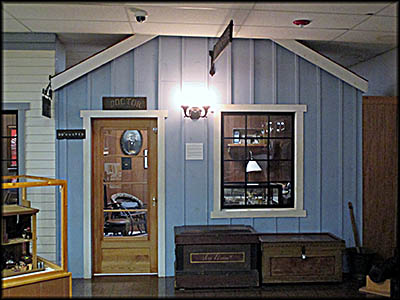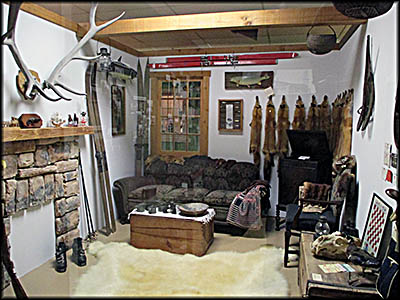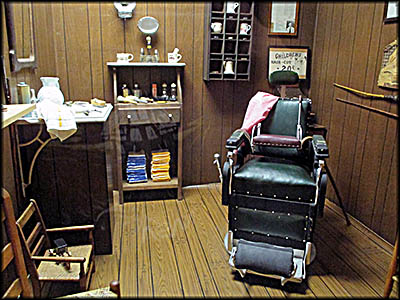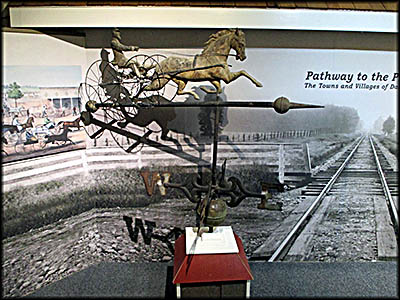Garst Museum

Garst Museum
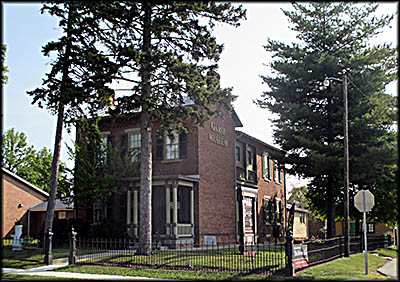
Run by the Darke County Historical Society, the Garst Museum has a massive collection of over 300,000 artifacts located in a 35,000 square feet building complex. It is the sort of institution you expect to see in Cleveland or Columbus, not the small city of Greenville, Ohio, where it resides. With just over 13,000 inhabitants, the city is by far Darke County’s largest town. It stands upon the remains of the Fort Greene Ville, which was named for Revolutionary hero Nathaniel Greene and built in 1793 on the order of General “Mad” Anthony Wayne. The largest fort of its kind in the area, it served as the launching point of his campaign to force the Native Americans living in southeastern Ohio (then just a part of the Northwest Territory) to make peace. They had been attacking U.S. citizens who had settled on their land without permission and who were most certainly not welcome.
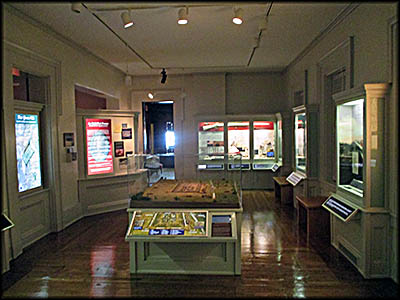
The Treaty Room is dedicated to telling the story of the Treaty of Greene Ville.
This President George Washington wanted to put a stop to, but he didn’t count on the tactical and strategic abilities of Miami war chief Michikinikwa, who is better known to whites as Little Turtle. It was he who defeated Washington’s first two U.S. military expeditions. The first was in 1790 and led by Josiah Harmer, whose undisciplined and underequipped Kentucky militia was no match for his Native American opponents. In 1791, Washington sent General Arthur St. Claire to deal with the situation, but an illness made it difficult for him to cope with running a militia not much more disciplined than the previous one. On the morning of November 4, 1791, he and his army of 1,400 men, then camped in a place latter dubbed Fort Recovery, found themselves surrounded by Native American warriors. Although he tried to put up a fight, St. Claire had to order a retreat to Fort Jefferson. The man charged with defending the retreating force’s rear, Colonel William Darke, did his job exceptionally well, and it was in his honor that Darke County took its name.
Undaunted by these losses, Washington put General Wayne in charge of dealing with the issue at hand. At this point Congress finally created a standing national army that Wayne trained before taking it into the field. It’s at this point I ought to mention that Darke County breeds and attracts famous Americans like a warren of rabbits. Among those in Wayne’s expeditionary force were William Henry Harrison, later a U.S. president, and Lewis Meriwether and William Clark, who went on to head the expedition that explored the Louisiana Purchase. Departing with a force of men from Fort Greene Ville, Wayne headed north to establish a series of forts. At the place called Fallen Timbers he defeated a Native American force, who by this point were no longer under the command of Michikinikwa.
In June 1795, representatives of the Chippewa, Delaware, Miami, Ottawa, Potawatomi and Wyandot people came to Greene Ville to negotiate a treaty. Notably absent was Chief Tecumseh of the Shawnee, who would fight another day only to and lose his struggle and life during the War of 1812. The Treaty of Greene Ville (or Greenville) was signed on August 3 by several prominent chiefs as well as Wayne himself. It opened up a large swatch of southeastern Ohio to settlers who the Native Americans pledged to leave in peace. Of course greedy American citizens hungry for land soon moved into other parts of Ohio and the whole conflict-to-treaty cycle happened again. In the end Andrew Jackson forced nearly all Native Americans out of Ohio and into the West. At the museum hangs the painting The Signing of the Treaty of Greene Ville by Howard Chandler Christy that includes portraits of Wayne, Clark, Lewis, Harrison, and Michikinikwa.
Undaunted by these losses, Washington put General Wayne in charge of dealing with the issue at hand. At this point Congress finally created a standing national army that Wayne trained before taking it into the field. It’s at this point I ought to mention that Darke County breeds and attracts famous Americans like a warren of rabbits. Among those in Wayne’s expeditionary force were William Henry Harrison, later a U.S. president, and Lewis Meriwether and William Clark, who went on to head the expedition that explored the Louisiana Purchase. Departing with a force of men from Fort Greene Ville, Wayne headed north to establish a series of forts. At the place called Fallen Timbers he defeated a Native American force, who by this point were no longer under the command of Michikinikwa.
In June 1795, representatives of the Chippewa, Delaware, Miami, Ottawa, Potawatomi and Wyandot people came to Greene Ville to negotiate a treaty. Notably absent was Chief Tecumseh of the Shawnee, who would fight another day only to and lose his struggle and life during the War of 1812. The Treaty of Greene Ville (or Greenville) was signed on August 3 by several prominent chiefs as well as Wayne himself. It opened up a large swatch of southeastern Ohio to settlers who the Native Americans pledged to leave in peace. Of course greedy American citizens hungry for land soon moved into other parts of Ohio and the whole conflict-to-treaty cycle happened again. In the end Andrew Jackson forced nearly all Native Americans out of Ohio and into the West. At the museum hangs the painting The Signing of the Treaty of Greene Ville by Howard Chandler Christy that includes portraits of Wayne, Clark, Lewis, Harrison, and Michikinikwa.
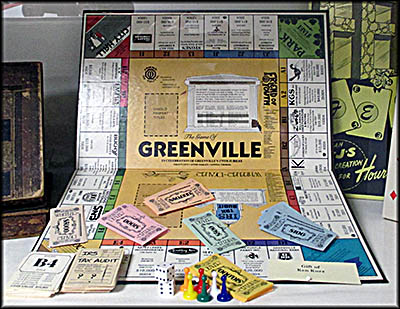
This is a special Monopoly
board made for Greenville.
board made for Greenville.
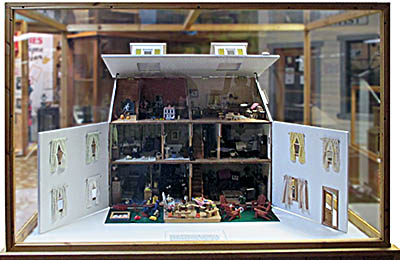
This dollhouse was made by
Marilyn and Dale Robbins in 1983-1984.
Marilyn and Dale Robbins in 1983-1984.


Darke County went quiet after this and remained largely isolated from the rest of Ohio for lack of decent roads. All that changed in 1850 with the arrival of the railroad. This allowed a mill industry to grow because now it could ship its products elsewhere. Greenville became the county seat. Farming remained an important part of Darke County’s economy as evidenced by the massive number of agricultural machines found in the museum’s Pioneer Wing. Here, for example, you can see a seed sorter and a lard press (yes, that’s a real thing). There are also a number of carriages and wagons, a JC Penny sign from the now long gone store once in downtown Greenville, and a 1958 Harley Davison Servi-Car once used by the Greenville police.
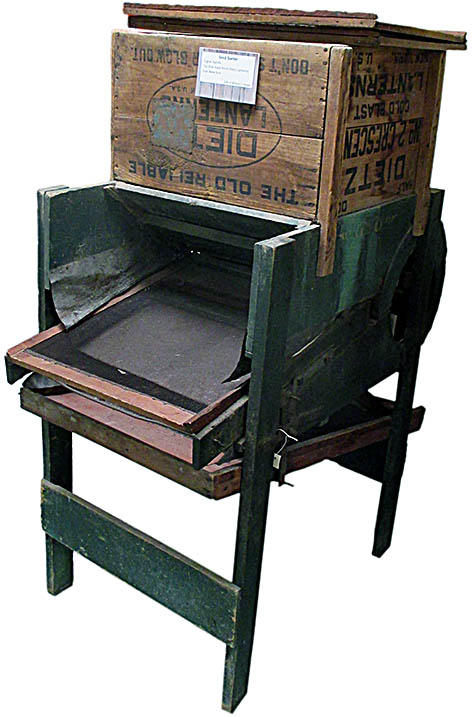
Seed Sorter
Every item in the museum is labeled with information signs that contain an impressive amount of general history about certain collections of objects. The sign for the sewing machine exhibit, for example, gives you a brief history of that appliance. The first sewing machine patent in the United States was issued to Elias Howe in 1846, but his machine failed commercially and left him in debt. In 1850 Allen Wilson patented his own version, as did Isaac Singer the next year. Both had improvements that included treadles for foot power, but theirs used the “lock-stich” mechanism invented by Howe. He therefore sued. Several years later the three men settled.
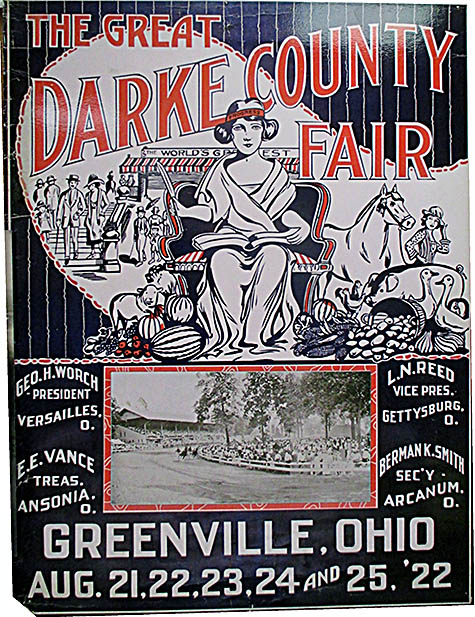
Also in the Pioneer Wing is an exhibit about the Darke County Fair’s history. Being a city boy with bad allergies, fairs have never held much appeal for me and writing about the history of them is not something I ever expected to do. But Darke County’s has some points of interest, so here we go. In 1852, Darke County residents formed the County Agricultural Society to plan for the creation of a county fair, the first of which was held the next year not far from the Garst Museum.
Although still popular today, from about 1880 to 1920 fairs were the sort of thing you looked forward to as much as Christmas. They were places where entertainment of the kind you’d probably never otherwise see took place, such as Famous Professor Hannon, who, a museum information sign reported, “did miraculous balloon ascensions and fantastic parachute leaps. Shooting and horse racing [also] became popular events.” At the 1905 Darke County Fair, one exhibition went terribly wrong. Professor James Baldwin ascended in a hot air balloon to demonstrate “aerial tactics from the Spanish American [sic] war using dynamite bombs. While he dangled from a hot air balloon at 1500 feet, all 7 bombs, weighing 6 pounds each, exploded simultaneously” with expected result that not much was left of the professor. The museum sign goes on to say, “Sadly, his wife and daughters witnessed the tragedy.”
Big country stars from the 1970s and 1980s have performed at the Darke County Fair, including Barbara Mandrell (who also once had a popular TV show), Loretta Lynn (she of “Coal Miner’s Daughter” fame), the Statler Brothers. Other acts include to come here are Sandi Patti (a Christian singer) and the rock/pop band Chicago.
The museum’s Village Wing contains a series of little shops representing those from the nineteenth and early twentieth centuries. Some are former businesses that were once found in Greenville while others are more generic representations, such as a doctor’s office. Before World War II most doctors had offices in their homes and were usually general practitioners, a sort of jack-of-all trades who prescribed medicine, delivered babies, set broken bones, and sometimes did a bit of surgery. Inside the doctor’s office is a wheelchair, and the information sign doesn’t neglect mentioning this. The earliest picture of a wheelchair comes from an 523 c.e. image from China, and the first modern one in West (called an “invalid’s chair”) appeared in 1595. The first electric wheelchair was made in London in 1916, and the first folding tube-based one appeared in 1932.
One of the strangest shops that once operated in Greenville was run by Lohmann Brothers. It began as a wagon making and repair business, then expanding into manufacturing telescopes and telescope lenses! William A. Lohmann founded the wagon making portion of the business in 1878, but it wasn’t until he brought his four boys into it that its purpose veered in such an unexpected direction. Three of the boys were into cameras and the youngest, Ed, got into astronomy and math. The brothers ground their own camera lenses, and Ed made a telescope with their aid. Ed’s telescope lenses went to observatories all over America and Europe. The largest Lohmann Brothers ever produced was delivered via rail to the Mount Wilson Observatory in Los Angeles. The family business collapsed during the Great Depression.
Big country stars from the 1970s and 1980s have performed at the Darke County Fair, including Barbara Mandrell (who also once had a popular TV show), Loretta Lynn (she of “Coal Miner’s Daughter” fame), the Statler Brothers. Other acts include to come here are Sandi Patti (a Christian singer) and the rock/pop band Chicago.
The museum’s Village Wing contains a series of little shops representing those from the nineteenth and early twentieth centuries. Some are former businesses that were once found in Greenville while others are more generic representations, such as a doctor’s office. Before World War II most doctors had offices in their homes and were usually general practitioners, a sort of jack-of-all trades who prescribed medicine, delivered babies, set broken bones, and sometimes did a bit of surgery. Inside the doctor’s office is a wheelchair, and the information sign doesn’t neglect mentioning this. The earliest picture of a wheelchair comes from an 523 c.e. image from China, and the first modern one in West (called an “invalid’s chair”) appeared in 1595. The first electric wheelchair was made in London in 1916, and the first folding tube-based one appeared in 1932.
One of the strangest shops that once operated in Greenville was run by Lohmann Brothers. It began as a wagon making and repair business, then expanding into manufacturing telescopes and telescope lenses! William A. Lohmann founded the wagon making portion of the business in 1878, but it wasn’t until he brought his four boys into it that its purpose veered in such an unexpected direction. Three of the boys were into cameras and the youngest, Ed, got into astronomy and math. The brothers ground their own camera lenses, and Ed made a telescope with their aid. Ed’s telescope lenses went to observatories all over America and Europe. The largest Lohmann Brothers ever produced was delivered via rail to the Mount Wilson Observatory in Los Angeles. The family business collapsed during the Great Depression.
In 1822 James Clemens founded a settlement composed of whites, blacks and Native Americans dedicated to racial equality and opposition to slavery. Initially located in Greenville, it soon separated from town and moved west near the Indiana border. Here it was named Longtown in honor of an open-minded blacksmith named James Long. Today nothing is left of it except for the Bethel Long Wesleyan Church, which has links to the original Bethel Wesleyan Methodist Church founded here in 1842.
As you leave the Village Wing and head into the Annie Oakley Room #2 (or vice versa), you will see a Wogaman Engine on display. Made in Greenville in the early 1900s, it’s a gasoline engine designed by H.H. Wogaman, who was born near Trotwood, Ohio, and eventually moved to Brookville to start a machine shop. There “he built,” according to the information sign, “the town’s first generator, first hydraulic elevator and first iron bridge.” He relocated to Greenville to be near its foundries, and here started Wogaman Manufacturing that produced the Sure-Go gearless engine. A true inventive polymath, “he also made the first ice machine in town, patented a multi-head drill and improved grain planter, and built the county’s first automobile engine.” During World War I his company produced artillery shells, but for reasons not revealed in the information sign, it closed in 1918.
Without a doubt the most famous person from Darke County is Annie Oakley about whom the museum has a major exhibit. Born in northern Darke County on August 13, 1860, as Phoebe Ann Moses, she had a very difficult childhood. At the age of six her father died. Her mother remarried but the second husband, Daniel Brumbaugh, died when Annie was just ten. At this point she was sent to the county workhouse, known as a the Infirmary, then to live with a farm family who treated her like a slave and may have sexually abused her. After two years of this she escaped. By this point her mother had married for a third time, so Annie stayed home. During the hard times of her youth, Annie learned to trap hunt for food. It was then that she discovered her talent for shooting.
As you leave the Village Wing and head into the Annie Oakley Room #2 (or vice versa), you will see a Wogaman Engine on display. Made in Greenville in the early 1900s, it’s a gasoline engine designed by H.H. Wogaman, who was born near Trotwood, Ohio, and eventually moved to Brookville to start a machine shop. There “he built,” according to the information sign, “the town’s first generator, first hydraulic elevator and first iron bridge.” He relocated to Greenville to be near its foundries, and here started Wogaman Manufacturing that produced the Sure-Go gearless engine. A true inventive polymath, “he also made the first ice machine in town, patented a multi-head drill and improved grain planter, and built the county’s first automobile engine.” During World War I his company produced artillery shells, but for reasons not revealed in the information sign, it closed in 1918.
Without a doubt the most famous person from Darke County is Annie Oakley about whom the museum has a major exhibit. Born in northern Darke County on August 13, 1860, as Phoebe Ann Moses, she had a very difficult childhood. At the age of six her father died. Her mother remarried but the second husband, Daniel Brumbaugh, died when Annie was just ten. At this point she was sent to the county workhouse, known as a the Infirmary, then to live with a farm family who treated her like a slave and may have sexually abused her. After two years of this she escaped. By this point her mother had married for a third time, so Annie stayed home. During the hard times of her youth, Annie learned to trap hunt for food. It was then that she discovered her talent for shooting.
To my surprise, much contradictory information about her life exists, some of this confusion being caused when the Buffalo Bill’s Wild West Show’s publicity people advertised her as six years younger. According to the museum, she was fifteen when she had her famous shooting contest with Francis “Frank” Butler in which she beat, then a year later, married him. Her entry in the scholarly and usually correct American National Biography (ANB) says the contest occurred either in 1875 or 1881, and she married in 1876 or 1882. Probably the earlier dates are correct. After marrying, the two toured on their own for a time, then joined the Sells Brothers Circus in 1883.
In addition to its many information signs about her, the museum also has pamphlet you can take that gives a synopsis of her life. It says when Buffalo Bill heard about her, he went to see her for himself and immediately hired her and Frank. But ANB says Bill refused to hire them because he already had a sharpshooting act, Captain Adam Bogardus, and it wasn’t until he left the show that he Annie brought the couple on board. In either case they joined in 1885.
She and Frank stayed with the show for seventeen years, although they parted ways for the 1888 season for reasons ANB didn’t know, but the Garst Museum does (which it posits as a theory). In 1886, Buffalo Bill’s show hired Lillian Smith, the self-proclaimed “Champion Girl Shot.” Annie disliked this fifteen-year-old and “thought she was an immoral flirt. Annie also did not like her use of the word ‘champion.’ When Buffalo Bill refused to fire Smith after the 1887 season, Annie and Frank left the show for one year.”
As talented a shot as she was, sometimes Annie still missed. When British gunmaker Charles Lancaster saw her do this few times during a show, he concluded her shotgun was the wrong size, so he made one to fit her small five foot tall frame. This worked so well that she had all her long guns made with the same dimensions. During performances both she and Buffalo Bill sometimes used smoothbore rifles to slow down the speed of their bullets in case they veered into the crowd of spectators. Sometimes they used .44 cartridges filled with pellets that gave them a shotgun effect. While this type of ammunition did make hitting a moving target a bit easier, its real benefit was that it was less dangerous if it hit the crowd.
The pamphlet says that at the age of 41 a train wreck seriously injured Annie’s head, causing her to leave the Buffalo Bill show. It also claims her hair turned white overnight because of it. This is nonsense. Unless someone snuck into her bedroom while she was sleeping and bleached it, it is medically impossible for hair to turn white overnight. But that isn’t the only contradiction here. ANB says the train wreck caused injury to her back, not head.
In 1902 she starred in a play written for her called The Western Girl. In 1903 a woman claiming to be “Any Oakley” was arrested for stealing and drug use. William Randolph Hearst reported this was the real Annie Oakley in fifty-five of his newspapers. Annie and Frank sued them all for libel and won fifty-four of fifty-five of their cases. It was costly, however, and from 1910 to 1913, the couple went back on the road to perform shows with Vernon Seaver’s Young Buffalo Show.
In addition to its many information signs about her, the museum also has pamphlet you can take that gives a synopsis of her life. It says when Buffalo Bill heard about her, he went to see her for himself and immediately hired her and Frank. But ANB says Bill refused to hire them because he already had a sharpshooting act, Captain Adam Bogardus, and it wasn’t until he left the show that he Annie brought the couple on board. In either case they joined in 1885.
She and Frank stayed with the show for seventeen years, although they parted ways for the 1888 season for reasons ANB didn’t know, but the Garst Museum does (which it posits as a theory). In 1886, Buffalo Bill’s show hired Lillian Smith, the self-proclaimed “Champion Girl Shot.” Annie disliked this fifteen-year-old and “thought she was an immoral flirt. Annie also did not like her use of the word ‘champion.’ When Buffalo Bill refused to fire Smith after the 1887 season, Annie and Frank left the show for one year.”
As talented a shot as she was, sometimes Annie still missed. When British gunmaker Charles Lancaster saw her do this few times during a show, he concluded her shotgun was the wrong size, so he made one to fit her small five foot tall frame. This worked so well that she had all her long guns made with the same dimensions. During performances both she and Buffalo Bill sometimes used smoothbore rifles to slow down the speed of their bullets in case they veered into the crowd of spectators. Sometimes they used .44 cartridges filled with pellets that gave them a shotgun effect. While this type of ammunition did make hitting a moving target a bit easier, its real benefit was that it was less dangerous if it hit the crowd.
The pamphlet says that at the age of 41 a train wreck seriously injured Annie’s head, causing her to leave the Buffalo Bill show. It also claims her hair turned white overnight because of it. This is nonsense. Unless someone snuck into her bedroom while she was sleeping and bleached it, it is medically impossible for hair to turn white overnight. But that isn’t the only contradiction here. ANB says the train wreck caused injury to her back, not head.
In 1902 she starred in a play written for her called The Western Girl. In 1903 a woman claiming to be “Any Oakley” was arrested for stealing and drug use. William Randolph Hearst reported this was the real Annie Oakley in fifty-five of his newspapers. Annie and Frank sued them all for libel and won fifty-four of fifty-five of their cases. It was costly, however, and from 1910 to 1913, the couple went back on the road to perform shows with Vernon Seaver’s Young Buffalo Show.
After another retirement from road shows, Annie still performed sporadically. In 1922 an automobile wreck crippled one her legs, so she took to wearing a steel brace, learning to shoot with it on. By 1926 she had become quite ill, so she and Frank moved to Greenville so family could help take care of her. On November 3 while visiting Annie’s sister in Ferndale, Michigan, Frank learned that his wife of fifty years had passed. He, too, had fallen ill and was too sick to return home. Eighteen days later he was also dead. All reports say theirs was a very close and loving marriage.
In the museum’s Americana Room, one will find much information about Lowell Thomas, another famous person from Darke County. He is one of those historical figures whose celebrity died with him, but his legacy is with us. It is his lecture tour that made the relatively obscure World War I British officer T.E. Lawrence into Lawrence of Arabia. Thomas became one of the most well-known and popular radio broadcasters in America and later starred in the TV show High Adventure that ran on CBS from 1957 to 1959. He also participated in the development and promotion Cinerama, which was ultimately a failure.
The Americana wing contains series rooms one would find in nineteenth and early twentieth century American homes. These aren’t especially exciting and a bit overdone. There are four bedrooms, three dining rooms, two parlors, and one kitchen. There is also an art gallery and the small Lowell Thomas Theater.
The Garst Museum contains far more than this exceptionally long travel log has covered. There is, for example, the excellent Military & Scouting Display, which is above the Treaty Room. There are also rooms dedicated to the history (and prehistory) of Ohio’s Native American people. I drove over three hours to reach this museum feel the trip was well was worth my time. When you visit, expect to spend about three hours to see everything.🕜
In the museum’s Americana Room, one will find much information about Lowell Thomas, another famous person from Darke County. He is one of those historical figures whose celebrity died with him, but his legacy is with us. It is his lecture tour that made the relatively obscure World War I British officer T.E. Lawrence into Lawrence of Arabia. Thomas became one of the most well-known and popular radio broadcasters in America and later starred in the TV show High Adventure that ran on CBS from 1957 to 1959. He also participated in the development and promotion Cinerama, which was ultimately a failure.
The Americana wing contains series rooms one would find in nineteenth and early twentieth century American homes. These aren’t especially exciting and a bit overdone. There are four bedrooms, three dining rooms, two parlors, and one kitchen. There is also an art gallery and the small Lowell Thomas Theater.
The Garst Museum contains far more than this exceptionally long travel log has covered. There is, for example, the excellent Military & Scouting Display, which is above the Treaty Room. There are also rooms dedicated to the history (and prehistory) of Ohio’s Native American people. I drove over three hours to reach this museum feel the trip was well was worth my time. When you visit, expect to spend about three hours to see everything.🕜

Lard Press
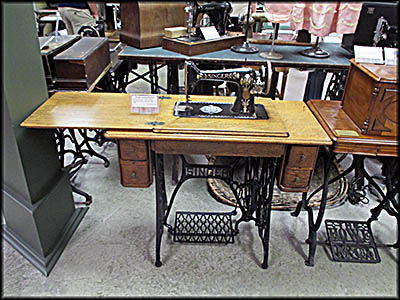
Treadle-powered Singer Sewing Machine
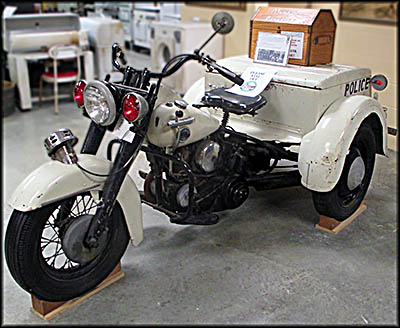
1958 Harley-Davison Servi-Car
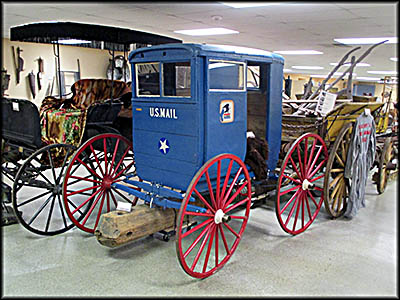
Carriages and Wagons
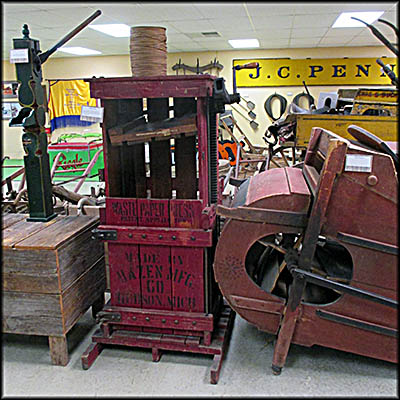
In the center is a paper baler.
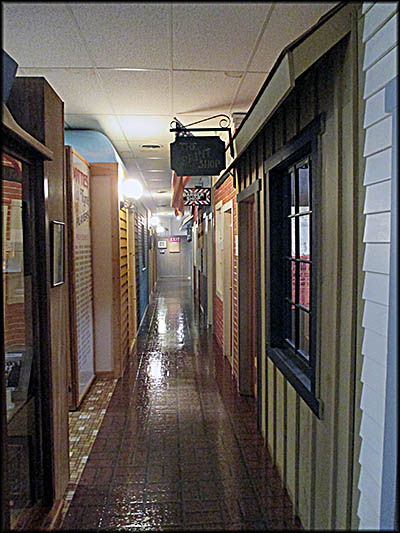
Storefronts in the Village Wing
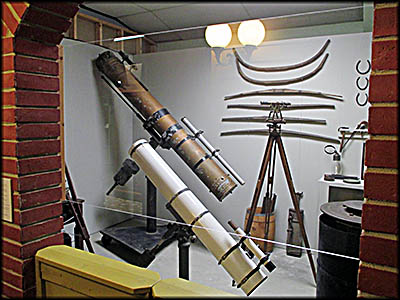
Lohmann Telescopes
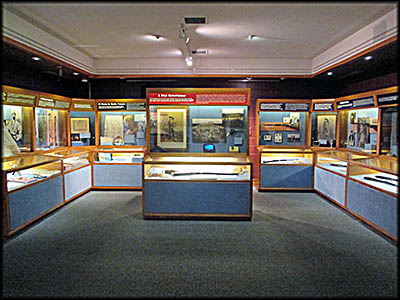
One of two rooms dedicated to Annie Oakley.
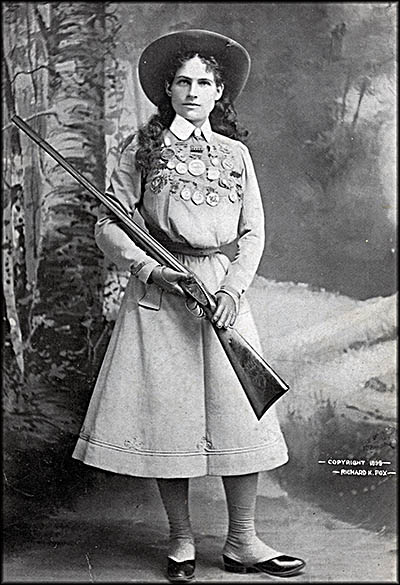
Annie Oakley
Library of Congress
Library of Congress
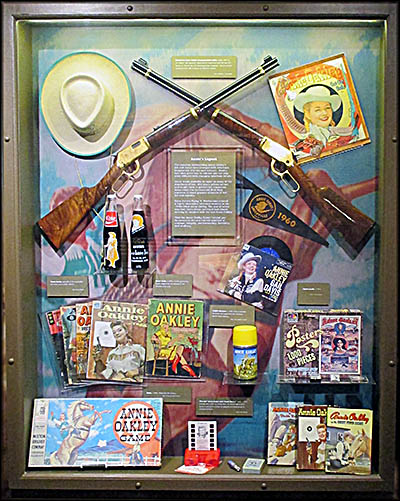
Annie Oakley has been a cash cow for a variety of companies that appropriated her image to see their junk.
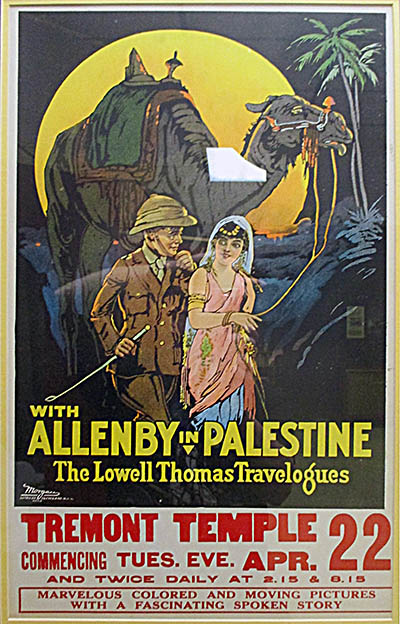
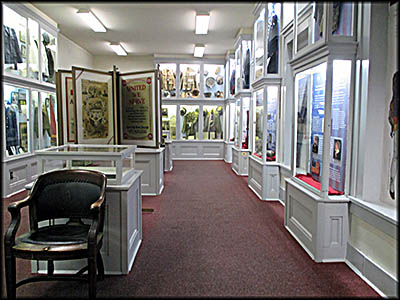
Military and Scouting Displays Room

